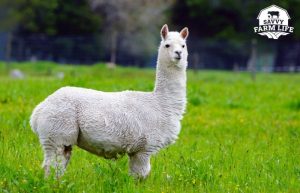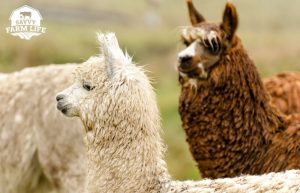
All You Need to Know About Alpaca Behavior
If you find yourself around alpacas, it is a good idea to learn as much about their behavior as possible. This not only allows you to understand the cues and language that the alpacas are displaying, but also ensures that you are not inadvertently encouraging negative behaviors.
There are a fews factors that greatly determine how alpacas communicate and why they display certain behaviors. Here are the major contributing factors to alpaca behavior:
- Alpacas are also prey animals, meaning it is in their nature to avoid danger or things threaten them in any way.
- Alpacas are social animals, and they maintain a hierarchy within their herd. They will communicate feelings of submission and dominance toward each other and humans.
- Alpacas are pseudoruminants, which means they have three stomach compartments. Their diet consists largely of forage from pasture and hay and they will need to graze on a consistent basis to stay healthy.
Understanding alpaca behavior is important in order to properly interact alpacas and provide them with adequate care.Read on for specific information about the behaviors you will see in alpacas.
Alpaca Behavior Guide: Prey Animal Instinct
The prey nature of alpacas plays perhaps the biggest role in determining other displayed behaviors. Being a prey animal means that it is in the alpaca’s nature to avoid danger or anything that may threaten them. They get adrenaline to run away from potential danger while predators get adrenaline to chase potential prey. That being said, if an alpaca seems nervous or uncertain about being near you, it can be a sign that they see you as a potential danger. Because of this, it’s important to spend time with your alpacas and show them that you are a friend rather than a foe.
Although alpacas are prey animals, they are one of the few prey animals that has sense enough to rally and fight of predators rather than just fleeing all the time. For this reason, many people will keep alpacas as livestock guardian animals to protect other small livestock or poultry.
Alpaca Behavior Guide: Herbivores
As prey animals, alpacas are herbivores. They are known as pseudoruminants, meaning they have three stomach compartments they use to process the vegetation they eat. Due to their digestive system, alpacas are designed to eat roughage in the form of grass and hay for the majority of the day. Grass and hay have natural sugars and proteins that the alpaca’s digestive system is made to effective extract.
It is ordinary behavior for alpacas to graze for hours at a time. They need to eat 1.5% of their bodyweight in forage each day to stay healthy. Usually, alpacas will graze for a bit and then doze for a bit, switching off between the two activities.
Alpaca Behavior Guide: Vocalizations
Alpacas use sound to express emotion or warnings. Below is a list of common sounds alpacas make and a brief description of what each sound means:
- Humming – alpacas hum for many reasons, including to express friendliness and in greeting, mild concern, and contentment.
- Clicking / Clucking – alpacas will click their tongues to express concern, desire for attention, happiness, or intimidation.
- Alarm / Screaming – alpacas will screech when danger is present, and will scream if under attack.
- Orgle – male alpacas will “orgle” to attract mates and during the act of mating
- Grumbling / Snorting – alpacas will grumble to express annoyance or irritation, and if that does not solve their problem they will snort to tell another alpaca to back off.
Alpaca Behavior Guide: Social Hierarchy
Due to their nature as prey animals, alpacas rely heavily on a community setting to provide them with safety and protection. Alpacas, like many herd or flock animals, have a hierarchy that they maintain. This usually involves one or two “alphas” – either dominant males or females. These alphas will warn the others of danger and will become particularly agitated if separated from the herd. Because of this social structure, it is recommended that no fewer than three alpacas be kept together. Keeping a minimum of three will allow them to feel safe within their group, and will also enable a social hierarchy to develop. As humans, we may not understand the importance of this hierarchy, but we should understand that alpacas feel safe and orderly within this delicate system.
Alpaca Behavior Guide: Body Language
How can you tell who is the alpha in the group, and who are the submissive alpacas? Understanding body language can reveal a lot about an alpaca herd.
Signs of Alpaca Submission
A submissive alpaca will raise his or her tail and will also lower the neck. These are not unlike the submissive behaviors you may see in a dog or other animal as well. If you see an alpaca with a raised tail and a lowered neck, that means they are submitting to an approaching alpaca. You may also see this behavior in a cria (baby alpaca) approaching a dam for milk.
Signs of Alpaca Dominance
Alpacas will stand “broadside” to one another in a show of dominance or agitation. This means they stand to the side with their tail placed to the right or left, which makes them look bigger to others. Alpacas will also display other dominant and aggressive behavior, including mounting, standing on their hind legs, snorting, and chest butting.
Do alpacas spit like llamas? Alpacas will spit like llamas in different situations. To learn more, visit my article Do Alpacas Spit? Everything You Need to Know.
Dominant Alpaca Behaviors Towards Humans
 Dominant behaviors from alpacas should never be encouraged with humans. This is a mistake that is made often and can be detrimental to the future of the offending alpaca. If a cria (baby) comes to you and chest butts you or stands on his or her hind legs to get food from you, you should discourage this behavior. This cria does not believe you to be a human, but rather a peer in the herd, and will grow up not respecting humans. People think it is “cute” that the alpaca is pushing up against them or invading their personal space, when the alpaca is really learning to display dominant behaviors with humans.
Dominant behaviors from alpacas should never be encouraged with humans. This is a mistake that is made often and can be detrimental to the future of the offending alpaca. If a cria (baby) comes to you and chest butts you or stands on his or her hind legs to get food from you, you should discourage this behavior. This cria does not believe you to be a human, but rather a peer in the herd, and will grow up not respecting humans. People think it is “cute” that the alpaca is pushing up against them or invading their personal space, when the alpaca is really learning to display dominant behaviors with humans.
What makes alpacas different than other small livestock when it comes to dominant behavior issues is that alpacas have a fighting streak in them. Because of this, alpacas are often used as livestock guardian animals since they will often fight and chase off predators. The last thing you want is these tendencies to be targeted towards humans.
To learn more about using alpacas as livestock guardians, visit my article What Are the Best Livestock Guardian Animals?
The Disposition of the Alpaca
Alpacas are prized not only for their beautiful fleece and the fact they are easy to keep, but also for their (generally) docile and gentle dispositions. Alpacas are typically friendly toward humans, and are especially good with children. They are not escape artists, content to wander and graze within the confines that their keepers set for them. Alpacas are smart, and have long memories. If you treat an alpaca poorly, they will remember and will not feel safe with you. For this reason, even as you discourage potentially aggressive behaviors in young alpacas, make sure to do so calmly and gently so as not to create distrust in the alpaca.
Are Alpacas Intelligent?
Alpacas are very intelligent! Alpacas are easily trained and learn their names if used repetitively. They also distinguish between people and develop bonds with their human keepers. Alpacas are observant and study human behavior and facial expressions just as we do the same with them. They have the ability to recognize physical objects and understand their uses, and can also be taught verbal commands.
Each alpaca herd, of course, is made up of several alpaca individuals. Some individual alpacas are more intelligent than others, some are more stubborn than others, and some are more aloof. On the whole, though, alpacas are highly trainable and quite intelligent.
Noticing Behavioral Changes in Alpacas
If you are familiar with your herd and each individual’s behaviors, you may notice behavioral changes along the way. One reason you may see behavioral changes in your alpacas is when mating (or when trying to mate). Previously agreeable males may become more aggressive, and previously cranky females may become more docile. Pregnancy may also bring about changes in behavior for a dam – just as it does in humans! Hormones are at play here, and can cause a dam to become more standoffish, more aloof, or even more energetic at times.
You may also see shifts in behavior if you add a new member to the herd or if something in the environment changes. As noted earlier, there is a delicate balance within the herd’s social structure, and any changes to that social structure may have a rippling effect. If this is the case, behaviors will usually settle with time.
Of course, if you notice a dramatic change in your alpaca’s behaviors and cannot figure out the reason, it is recommended that you have your alpaca checked out by a vet – he or she could be in pain or ill, and their behavior change might be the only obvious symptom.
Spending Time With Alpacas
If you have a herd of alpacas, it is important to spend time with them. This will show you each of their individual personalities and behavior traits, and more time spent with them will allow you to encourage positive behaviors, discourage negative and aggressive behaviors with humans, and notice if anything is amiss. Of course, spending time with your alpacas is also a treat, and is a way to bond with your herd.
Want to know more about caring for alpacas? Visit my article Are Alpacas Hard to Care For? Alpaca Care Essential Guide.
